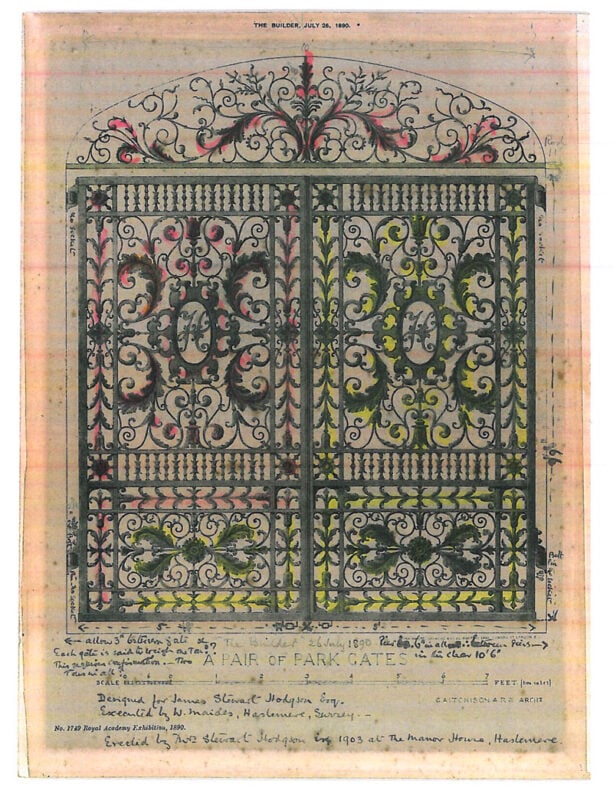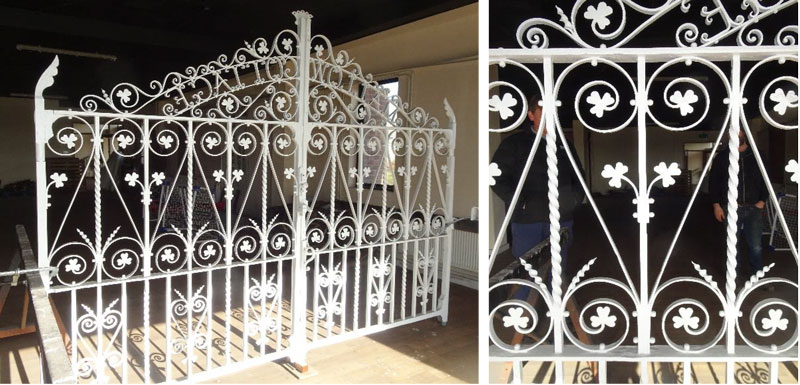The Haslemere Gates were originally erected at The Manor House Estate in Haslemere, Surrey, a Grade II listed building in England. Designed by Frederick Pepys Cockerell and later extended by George Aitchison, the estate was owned by James Stewart Hodgson, a prominent partner in Barings Bank. After the bank’s collapse in 1890, Hodgson was forced to sell his cherished Lythe Hill House in 1894, along with many of his possessions. The gates, crafted by local blacksmith W. Maides, were believed to have been moved to The Manor House in Haslemere around 1903.

When Hodgson’s daughter, Agatha Hodgson, married Captain George Ulick Browne in 1887, the gates found a new home. Upon George Browne’s inheritance of the title of the 6th Marquess of Sligo in 1913, the couple relocated to Westport House, bringing the gates with them. These gates, adorned with intricate repoussé leaf work and the distinctive letter “H,” remain an essential symbol of the family’s legacy and the artistic tradition of the late 19th century.

Why Restoring the Haslemere Gates Matters
The Haslemere Gates hold profound architectural, artistic, and historical significance. As one of the most ornate gate designs in Ireland, their elaborate craftsmanship, particularly the repoussé leaf work, is a rare example of decorative wrought ironwork. The gates also symbolise the historic connection between the Stewart Hodgson and Browne families, whose journeys from Haslemere to Westport reflect broader narratives of British and Irish aristocracy during the 19th and early 20th centuries.
Yet, the gates’ importance goes beyond their aesthetic and historical value. As a part of the National Inventory of Architectural Heritage and the Westport Town & Environs Plan, they are recognised as essential elements of both local and national heritage. Their restoration is crucial not only to preserve this cultural asset but also to enhance the historic setting of Westport House and its gardens, drawing visitors and heritage enthusiasts from far and wide.

The Restoration: A Master Blacksmith at Work
The restoration of the Haslemere Gates is being entrusted to master blacksmith John Hogan, whose expertise in the repair and conservation of metalwork is widely acknowledged. Hogan, based in Killala, County Mayo, has previously restored other historic works, including the gates at Mallow Cottage in Westport and a Turner glasshouse at Rokeby Hall, Co. Louth, which won the prestigious An Taisce Ellison Award for Conservation and Restoration in 2014.

The proposed work on the Haslemere Gates is extensive. Given the gates’ poor condition—much of the hand-forged decorative details are either missing or corroded beyond repair—Hogan will painstakingly hand-forge new elements based on the original drawings and the surviving parts of the gates. The process will involve using genuine wrought iron and traditional blacksmithing techniques to replicate the intricate scrollwork, leaf work, and other decorative details.

Challenges and Solutions: The Condition and Scope of Work
The restoration faces several challenges due to the gates’ exposure to harsh weather from Clew Bay and the lack of maintenance over the years. Fortunately, much of the main frame and internal framework remain intact and can be repaired. However, the intricate decorative elements, particularly the repoussé leaf work and rosettes, have suffered significant corrosion. To address this, Hogan will use both the original 1890 drawing and the remaining fragments to authentically reproduce these elements.
The scope of the work includes:
- Conducting a detailed photographic survey before dismantling.
- Carefully tagging all parts and cross-referencing them to a drawing.
- Preparing a method statement and safety statement for approval.
- Using soda blasting to clean the gates gently.
- Forging new elements using traditional techniques and materials.
- Applying a multi-layer protective coating, including an anti-rust primer and marine-grade paint, to ensure durability.

Conclusion: Preserving the Past for Future Generations
The restoration of the Haslemere Gates is more than a repair project; it is a mission to preserve a vital piece of history. These gates, once fully restored, will not only reclaim their rightful place as a centrepiece of Westport House’s architectural splendor but will also serve as a reminder of the rich cultural narratives they embody. By investing in their restoration, we ensure that future generations can appreciate their beauty, history, and craftsmanship, reinforcing the importance of preserving our shared heritage.
As these gates once again stand proud at the entrance to the south terrace, they will do more than enhance the estate’s setting; they will become a symbol of resilience, artistry, and the enduring legacy of those who came before us.
Follow us on Instagram to keep up to date with the progress of these beautiful and historical gates.
